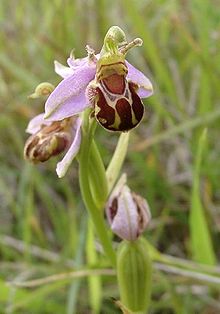- Bee Orchid
-
- The orchid species Diuris carinata is also known as Bee Orchid.
Bee orchid 
Bee Orchid (Ophrys apifera var. aurita) Scientific classification Kingdom: Plantae (unranked): Angiosperms (unranked): Monocots Order: Asparagales Family: Orchidaceae Subfamily: Orchidoideae Tribe: Orchidae Subtribe: Orchidinae Alliance: Orchis Genus: Ophrys Species: O. apifera Binomial name Ophrys apifera
Huds.Synonyms - Orchis apifera (Huds.) Salisb.
- Arachnites apifera (Huds.) Hoffm.
- Ophrys chlorantha Hegetschw. & Heer
- Ophrys insectifera var. andrachnites
The Bee Orchid (Ophrys apifera) is an herbaceous perennial plant belonging to the family Orchidaceae.
Contents
Etymology
The name "Ophrys" derives from the Greek word "ophrys", meaning "eyebrow", while the Latin name of the species "apifera" refers to the bee-shaped lip.
Description
The Bee Orchid grows to a height of 15–50 centimetres (5.9–20 in). This hardy orchid develops small rosettes of leaves in autumn. They slowly continue to grow during winter. Basal leaves are ovate or oblong-lanceolate, upper leaves and bracts are ovate-lanceolate and sheathing. The plant blooms from mid-April to July producing a spike composed from one to twelve flowers. The flowers have large sepals, with a central green rib and their color varies from white to pink, while petals are short, pubescent, yellow to greenish. The labellum is trilobed, with two pronounced humps on the hairy lateral lobes, the median lobe is hairy and similar to the abdomen of a bee. It is quite variable in the pattern of coloration, but usually brownish-red with yellow markings. The gynostegium is at right angles, with an elongated apex.
Reproduction
It is the only species of the genus Ophrys, which preferentially practice the self-pollination. The flowers are almost exclusively self-pollinating in the northern ranges of the plant's distribution, but pollination by the solitary bee Eucera occurs in the Mediterranean area. In this case the plant attracts these insects by producing a scent that mimics the scent of the female bee. In addition, the lip acts as a decoy as the male bee confuse it with a female. Pollen transfer occurs during the ensuing pseudocopulation.
Bees in the past have promoted the evolution of bee orchids. Male bees, over many generations of cumulative orchid evolution, have built up the bee-like shape through trying to copulate with flowers, and hence carrying pollen.[1]
Distribution
The Bee Orchid is a temperate climate species, widespread from the Atlantic to the Caucasus. It is quite common in the Mediterranean region eastwards to the Black Sea but is less common in its northern range being uncommon or local in Germany and Ireland. In the UK it has a distinct south-eastern preference, being more common in England, whereas it is only to be found in coastal regions of Wales and some parts of Northern Ireland. In Scotland it was thought to be extinct, but was rediscovered in Ayrshire in 2003. In some countries the plants have protected status. They are unusual in that in some years they appear in great numbers, then sometimes only reappear after an absence of many years.
Habitat
Orchis apifera generally grows on semi-dry turf, in grassland, on limestone, calcareous dunes or in open areas in woodland. It prefers calcareous soils, in bright light or dim light, , at an altitude of 1,200–1,400 metres (3,900–4,600 ft) above sea level.
Culture
The Bee Orchid is the County flower of Bedfordshire.[2]
Subspecies
- Ophrys apifera var. apifera
- Ophrys apifera var. bicolor
- Ophrys apifera var. botteronii
- Ophrys apifera var. friburgensis
- Ophrys apifera var. immaculata
- Ophrys apifera var. trollii
Gallery
References
- ^ Dawkins, R. (1986) The Blind Watchmaker
- ^ Plantlife website County Flowers page
- Pignatti S. - Flora d'Italia (3 voll.) - Edagricole – 1982, Vol. III
- Tutin, T.G. et al. - Flora Europaea, second edition - 1993
External links
Western marsh orchid (1989) | Pyramidal orchid (1990) | Green-winged Orchid (1991) | Listera ovata (1992) | Military Orchid (1993) | Fen orchid (1994) | Bee Orchid (1995) | Cypripedium calceolus (1996) | Bug Orchid (1997) | Marsh Helleborine (1998) | Lizard Orchid (1999) | Red Helleborine (2000) | Autumn Ladies'-tresses (2001) | Bird's-nest Orchid (2002) | Fly Orchid (2003) | Frog Orchid (2004) | Burnt orchid (2005) | Broadleaf Helleborine (2006) | Southern Marsh Orchid (2008) | Early Purple Orchid (2009) | Cypripedium calceolus (2010) |Categories:- Ophrys
- Orchid species
- Flora of Europe
- Flora of Asia
- Flora of Lebanon
Wikimedia Foundation. 2010.









